Nature & Environment 2004
Nature conservation
Several international agreements have been made to protect nature and ensure the masses of plant and animal species. The agreements obligate Member States to protect vulnerable natural habitats, providing the flora and fauna favourable growth and habitat conditions.
International provisions
Denmark has committed itself internationally to strengthening efforts to safeguard biodiversity through the international agreements we have entered into, including the 1992 UN Convention on Biological Diversity, and through cooperation within the EU. The overall objective to stop the loss of biodiversity by 2010 is included in a number of the international efforts which Denmark is part of. This objective makes up the framework for nature conservation, nationally as well as internationally.
The UN Convention on Biological Diversity
The objective of the Convention on Biological Diversity is not only to protect biodiversity, but also to ensure that nature's resources are utilised in a sustainable manner and to secure a fair division of the benefits from genetic resources. In this manner the Convention combines the preservation of nature with consideration of development and reaches far further than previous nature protection conventions that have focused on particularly threatened species or habitats.
At the Biodiversity Convention's sixth Conference of the Parties in 2002, a strategic plan was adopted to achieve the overall objective of a significant reduction in the loss of biodiversity before 2010.
The plan included these four strategic goals:
- The Convention is fulfilling its leadership role in international biodiversity issues.
- Parties have improved financial, human, scientific, technical, and technological capacity to implement the Convention.
- National biodiversity strategies and action plans and the integration of biodiversity concerns into relevant sectors serve as an effective framework for the implementation of the objectives of the Convention.
There is a better understanding of the importance of biodiversity and of the Convention, and this has led to broader engagement across society in implementation.
Biodiversity in the EU - Natura 2000
The EU has an overall goal of halting the loss of biodiversity by 2010. An important instrument in this respect is the establishment of the Natura 2000 network of bird protection and habitats sites. Natura 2000 Sites will form an ecological network of protected natural habitats throughout the EU.
Natura 2000, thus, is the collective term for Special Protection Areas (SPAs) and Special Areas of Conservation (SACs).
- SPAs have been designated in an effort to preserve populations of rare breeding birds or large concentrations of migrating birds. They include Ramsar sites, i.e. wetlands of special importance for birds.
- SACs have been designated to preserve populations of rare animals and plants as well as different types of natural habitat.
The Directives contain two main principles for conserving Europe's nature:
- Member States have to designate, conserve, and manage special protection areas which hold nature types or serve as habitats for species which have been declared protection worthy at Community level.
- Member States have to conserve specified species against collection, extermination, exploitation etc, as well as ensure their breeding sites and resting places against damage or destruction.
Member States have thus committed themselves to managing these areas so as to ensure that species and habitats are given favourable conservation status.
Danish species and habitats covered by Natura 2000
Almost 60 different types of Danish habitat are covered by Natura 2000, such as white dunes and wandering dunes, beech woods and coastal meadows.
Natura 2000 provisions apply to plant, mammal, bird, reptilian, amphibian, fish, and invertebrate species in Denmark. The species of mammal included in Natura 2000 in Denmark are listed below:
- Birch mouse
- Bat
- Grey seal
- Common dormouse
- Whale
- Common porpoise
- Otter
- Pine marten
- Common seal
Source: Danish Forest and Nature Agency

Water Framework Directive
The Water Framework Directive will be at the heart of EU water policy in the decade to come. The Directive will be the general framework for conserving watercourses and lakes, transitional water bodies (estuaries, lagoons/fjords etc.), coastal water and groundwater. The Directive defines a number of environmental targets to be met within a set deadline. Furthermore, it sets out an overall framework for administrative structure, planning and implementation of measures, and for monitoring of the aquatic environment. Filling in the details of the framework is to a large extent up to the individual Member States.
The EU Water Framework Directive entered into force on 22 December 2000. In December 2003, the Danish Parliament adopted a new Environmental Targets Act implementing the Directive in Danish legislation. The Environmental Targets Act (Lov om Miljømål etc.) testifies to the decision by the Danish Ministry of the Environment to combine the implementation of the Water Framework Directive with the implementation of parts of the Birds and Habitats Directives (conservation of certain types of habitat, wildlife and plant).
Actual implantation of the Water Framework Directive,
i.e. commencing steps to meet the environmental targets set out by the Directive, will be over a number of years. When defining targets, the entire water cycle must be taken into account. For instance, the
impacts on surface water in watercourses and lakes should not prevent compliance with the environmental targets set for groundwater.
Source: Danish EPA
Areas in Denmark protected internationally
Internationally protected nature areas in Denmark comprise:
- 254 habitats (SACs)
- 113 bird protection areas (SPAs)
The areas cover 8.3 per cent or 3,591 km2 of Danish land and 12 per cent or 13,047 km2 of Danish seas. They comprise the majority of the most important natural areas in Denmark.
The areas are today protected by comprehensive Danish environmental protection legislation, including special guidelines for management of the areas. Denmark is to safeguard or restore a favourable conservation status for the species and natural habitat types characteristic of the areas designated. In many cases, this requires action. Therefore, new regulation has been prepared which requires the adoption of binding management plans for each area effective from 2009, the so-called Natura 2000 plans. The plans will involve a survey and assessment of status and threats, nature quality targets, and an initiatives plan.
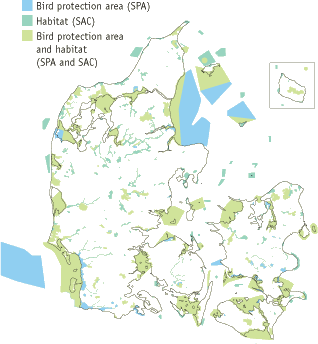
Source: National Environmental Research Institute (NERI) after: Danish Forest and Nature Agency's nature and forest figures for 2003
Habitats and Birds Directives implementation
In 2004, the European Commission approved Denmark's designation of Natura 2000 sites. These include a total of 254 habitats and a total of 113 bird protection areas on land and at sea.
These areas today are protected by comprehensive Danish nature-conservation and environmental-protection legislation supplemented by special management guidelines e.g. in the Ministry of the Environment's statutory order on management of internationally protected areas (including guidelines). The Danish Protection of Nature Act and in particular the general provisions of section 3 are the legal foundation for conservation of land areas in Denmark. This Act is supplemented by several regulations pertaining to area use in a number of other acts dealing with watercourses, forests, spatial planning, environmental protection, etc., as well as in specific instruments pertaining to listing of protected areas, wildlife reserves, nature management, etc.
The Habitats Directive has been implemented in Danish legislation in a process where legislation and practice have been adjusted continuously as the scope of the Directive is clarified e.g. in the European Court of Justice. Thus, in the 2003-2004 Parliamentary year, further amendments were made to the Danish Protection of Nature Act and the Danish Forest Act, and new tools were prepared e.g. for planning and intervention in particularly urgent cases where Denmark's EU commitments are involved.
In December 2003, the Danish Parliament adopted the Environmental Targets Act (Lov om Miljømål etc.) setting out more detailed planning-related guidelines for establishment, with effect from 2009, of actions plans for the aquatic environment and Natura 2000 as the collective basis for active management of the Water Framework Directive and the Natura 2000 Directives.
Natura 2000 planning under the Environmental Targets Act includes:
- carrying out a basis analysis
- setting out targets for the state of the individual site
- establishing an initiatives programme.
The purpose of the basis analysis is to establish a factual basis for specific prioritisation of management efforts, so as to document whether initiatives paramount to complying with the Habitats and Birds Directives are being launched as required. Continuous improvement of the knowledge base for Natura 2000 natural habitats, species, and their development will also be ensured via Denmark's national nature monitoring programme 2004-09, called NOVANA.
Thus, the basis analysis will be the foundation for target setting in relation to the designated areas, including balancing possible conflicting nature interests. Furthermore, it will serve as the basis for national prioritising of areas and initiatives.
In 2003, the National Environmental Research Institute published a technical report on criteria for favourable conservation status, which considers a number of technical parameters to be used when assessing whether the state of Natura 2000 sites and species is satisfactory or needs supplementary efforts. The development of these technical criteria is therefore an important contribution to future Natura 2000 planning, including the introduction of targets for favourable conservation status and initiatives planning.
By 2009 binding management plans will be available for each Natura 2000 site. These plans will contain a survey and assessment of status and threats, nature quality targets, and an initiatives plan. Natura 2000 plans will be coordinated with similar plans for water bodies in the Water Framework Directive.
Member States have committed themselves to administrating the areas with a view to ensuring that species and habitats are given favourable conservation status. This commitment pervades Danish initiatives regarding biodiversity in the years to come.
Other national nature conservation efforts
In 2003, the Government prepared an action plan for biodiversity conservation to ensure that Denmark is meeting the requirements and expectations outlined in the UN Convention on Biological Diversity and nature conservation requirements in the EU. Efforts include e.g. safeguarding existing natural areas of high quality and developing a network of protected natural habitats (the NATURA 2000 network in accordance with the Habitats Directive). Moreover, activities within agriculture, forestry, fisheries, and other sectors will be on sustainable basis.
The action plan is based on further development of wellproven activities (e.g. on initiatives in the three generations of action plans for the aquatic environment) but also introduce new approaches. It is a framework plan for the overall initiatives the Government will instigate in order to safeguard biodiversity and preserve nature. It will not stand alone, but will be accompanied by other nature and environmental initiatives, for example those mentioned in the following.
Denmark's national legislation contains essential administrative tools for the conservation and restoration of biodiversity. Recently, important amendments have been made to the Danish Protection of Nature Act and the Danish Forest Act to ensure better protection of nature and forests. Currently, freshwater and coastal meadows, marshes, heathland, dry grassland, and lakes (open-land habitats) are protected against further decline in area by section 3 of the Danish Protection of Nature Act.
Denmark has launched seven national park pilot projects as a step towards halting the loss of biodiversity before 2010. These pilot projects will be completed with a report in 2005. The report will describe visions, contents, and limitations of possible national parks in Denmark. Nature, outdoor recreation, and historical-cultural environments, as well as socio-economic and business economic consequences will be surveyed and clarified (see textbox on page 17).
In the period 2005 to 2008, DKK 200 million (EUR 26.8 million) have been allocated for use in extra nature protection efforts. The money will be spent on watercourses, river valleys, lakes, coastal
meadows, raised bogs, city-fringe natural habitats, and paths. Efforts will enable initiatives in international nature protection areas and will be an extension
of earlier nature management initiates to conserve existing nature and establish new nature where feasible and beneficial.
The Environmental Targets Act (Lov om Miljømål etc.) adopted in 2003 coordinates efforts within water and nature planning with a view to establishing greater correspondence between the quality of nature and Danish water resources. The purpose is to honour Denmark's commitments under the EU Habitats and Water Framework Directives. Amendments to the Danish Protection of Nature Act and the Danish Forest Act were adopted in 2004. Their aim is to provide for better protection of Natura 2000 sites and establish the tools necessary to carry out the Natura 2000 plans.
Action Plan for the Aquatic Environment III, launched by the Government in April 2004, will continue developments set in motion by the first two plans. The aquatic environment will be further improved through reductions in the discharges of nitrogen and phosphorus, and nature conservation regards will be maintained via e.g. the establishment of spray-free buffer zones along lakes and watercourses. In addition, 300-meter protection zones will be established around the most important natural habitats where there can be no expansion or new establishment of livestock production.
Spatial planning by counties and municipalities constitutes an important tool in the conservation and restoration of biodiversity. Nature planning will be given a boost to make it a suitable prioritisation tool in the conservation and restoration of nature. One major challenge will be to carry on work by local and regional authorities after implementation of the municipality structural reform in 2007 under which the new municipalities will have responsibility for day-to-day management of the Government's nature and environment policies.
A new combined water and nature monitoring programme 2004-2009 (NOVANA) has been set up and it will contribute to and work together with other water and nature planning in response to the Water Framework and Natura 2000 Directives.
The Government will design new, specific initiatives for the conservation of a series of priority natural habitats, such as nutrient-poor heathland, ponds and water meadows, dry grassland, and clear-water lakes. Furthermore, management plans will be prepared for special and rare species, and species towards which Denmark is especially committed.
National parks in Denmark
There is little space for nature in a small, densely populated country like Denmark. Therefore, the Government has launched pilot projects on the establishment of national parks in sites across the country where the natural environment has special significance.
National parks may provide wildlife and plants with large coherent areas in which to thrive. Similarly, people are allowed greater opportunity for enjoying and experiencing the beautiful and characteristically Danish landscape and wildlife.
The pilot projects will collect experience on how to best establish national parks with local involvement, and how to balance nature and wildlife concerns with those of tourism and industry.
There are seven pilot areas:
• Lille Vildmose
• Læsø
• Mols Bjerge
• Møn
• Kongernes Nordsjælland
• Thy
• The Wadden Sea
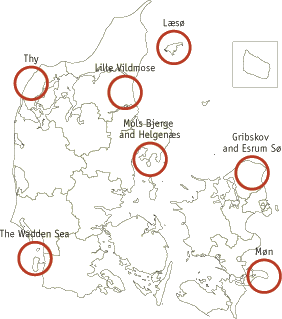
Source: Danish Forest and Nature Agency
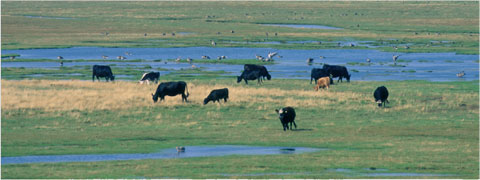
Protected natural habitat types
The protected open-land habitat types (dune, heathland, coastal meadow, freshwater meadow, dry grassland, and marsh) were most widespread in Denmark 200 years ago when they covered up to 60 per cent of the country. Today, however, these habitats cover less than 9 per cent of Denmark. Regional distribution of the habitat types shows that heathland is most common on the sandy and nutrient-poor soil in West Jutland, whereas on the more fertile moraine soil in East Jutland and on Funen and Zealand dry grassland is the predominant habitat type. Open-land natural habitat types are today protected against further decline in area by section 3 of the Danish Protection of Nature Act. Almost 50 per cent of the areas have moreover been designated as Natura 2000 sites providing them double protection; a fact visible in the table below. Historically, the decline in area of open-land habitat types has been accompanied by fragmentation and general reduction of natural areas in Denmark.
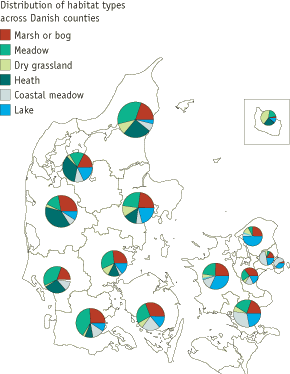
Source: National Environmental Research Institute (NERI), Miljøtilstandsrapport 2005 (The State of the Environment in Denmark 2005)
| Open-land natural habitat type |
Area (ha) | % of Denmark's land area |
% situated in Natura 2000 habitat sites |
| Dry grassland | 25,986 | 0.6 | 23.6 |
| Heathland | 82,013 | 1.9 | 49.7 |
| Freshwater meadows | 103,722 | 2.4 | 56.1 |
| Marshes | 89,919 | 2.1 | 32.6 |
| Coastal meadows | 43,622 | 1.0 | 76.4 |
| Dunes (estimated) | 30,000 | 0.7 | - |
| Total | 375,262 | 8.7 | 47.2 |
9 NATIONALLY PROTECTED AREAS
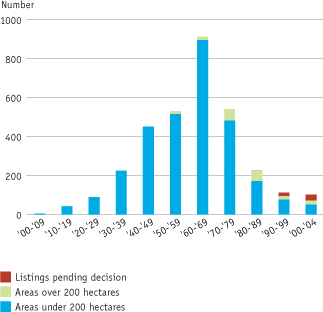
Source: Danish Forest and Nature Agency
The graph shows the number of areas entered on the National List of Protected Areas in the period 1900 to 2004: a total of 5034 protected areas. These do not include the around 1,100 protected areas near old churches, the so-called Provst-Exner listings. Until 1999, the protected areas are divided in time intervals of a decade's length. The graph shows when the areas were formally entered on the National List of Protected Areas. Typically, from it is initialised till it is finalised a listing takes between 2 and 10 years. The graph shows the number of protected areas under 200 hectares and the number of large areas of over 200 hectares. Overall, 4 to 5 per cent of Denmark's land area is protected.
The purpose of entering areas on the National List of Protected Areas is to safeguard valuable landscapes and valuable natural and historical-cultural areas. It is applied when the relevant areas cannot be protected through other legislation. The graph shows that the number of areas entered on the Natinal List of Protected Areas gained speed in 1920 when work to protect nature became organised. This was after adoption of Denmark's first Nature Protection Act in 1917. At the centre of efforts were characteristic geological formations and beautiful vistas. In the following decades, protection efforts broadened their aim and the number of areas entered on the National List of Protected Areas increased up through the 1930s and 40s. In the period 1940 to 70, the number of listings finalised rose dramatically. Listing of protected areas was then used as a means of stopping the building boom in the open countryside of summer and year-round residences, as well as a dramatic rise in raw material extraction of e.g. gravel, sand, clay, and chalk. The number of listings, however, has fallen in the period 1980 to 2005, partly because protection interests have been secured gradually through other landuse, sector, and spatial planning legislation, and partly because the most valuable areas have already been entered on the National List of Protected Areas.
The graph seems to point to the fact that planning and general protection efforts under other legislation have gained momentum as a key instrument in nature protection work. Despite the many listings, however, there is still a need to carry out a not insignificant number of listings and other protection means of Denmark's natural and historical-cultural environments. New protection needs arise continually as a consequence of developments in society, and they cannot be met under other land-use legislation. Furthermore, since the 1992 Protection of Nature Act, a number of cases regarding nature restoration have been raised.
10 AREAS ACQUIRED BY THE STATE FOR NATURE MANAGEMENT
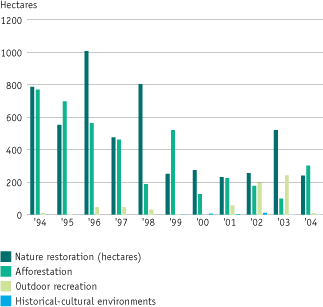
Source: Danish Forest and Nature Agency
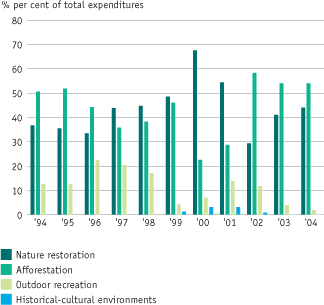
Source: Danish Forest and Nature Agency
The figures illustrate efforts to preserve and restore habitats for indigenous species of plants and animals. The figures provide an overview of the annual efforts made with funding from state nature management funds. The topmost figure shows the extent of the areas acquired by the state for nature management, measured in hectares. The area acquired per year, measured in hectares, is evidence of the physical efforts made and their relative distribution within the areas nature restoration, afforestation, outdoor recreation, and historical-cultural environments. Improvements favouring outdoor recreation and historical-cultural considerations are often incorporated in state nature restoration and afforestation programmes. The bottommost figure illustrates the prioritisation of the action areas within state nature management divided into nature restoration, afforestation, outdoor recreation, and historical-cultural environments measured in per cent of the total funds allocated for nature management.
Up until 1998, the aim was to spend 40 per cent of these funds on nature restoration, 40 per cent on afforestation, and 20 per cent on outdoor recreation. After 1998, the aim has been to distribute the funds as follows: 40 per cent on nature restoration, 30 per cent on afforestation, 20 per cent on outdoor recreation, and 10 per cent on historical-cultural environments. From 2002, in principle, historical-cultural environment has been discontinued as an independent project criterion.
Deviations can be made from this distribution in connection with relevant projects and changes in the annual allocations of funds. From 1999-2001, a significant part of the annual funds were earmarked for
the Skjern River Project, which means that nature restoration accounts for a high percentage of the total annual expenditure in this period. In 2002, there was co-funding from e.g. public waterworks and
municipalities earmarked for afforestation,
so that more nature management funds were channelled to afforestation in that year. The level of acquisitions of areas for nature restoration and afforestation has fallen since 1998. This is partly due to the fact
that a significant number of the annual nature management funds as mentioned were earmarked for the Skjern River Project dur
ing the period 1999 to 2001. Furthermore, some of the land bought in 2002 and 2003 for the purpose of afforestation included buildings making the price per hectare considerably higher than in previous
years.
The nature restoration projects help fulfil international obligations, e.g. in connection with the EU Bird and Habitats Directives, and the UN Convention on Biological Diversity. Afforestation supports national political goals and helps, in particular, to protect vulnerable groundwater resources which are used as drinking water supply, and contributes to the establishment of recreational areas close to urban areas - often in cooperation with waterworks and municipalities.

Conservation and restoration of coastal dune heaths
Coastal dune heaths are rare in Europe. In Denmark, however, this habitat type exists in relatively large areas, which Denmark consequently has a special obligation to conserve. Coastal dune heaths are habitat for plants and wildlife that depend on the dynamics of the nearness to the sea. In many places, overgrowing with trees, inadequate grazing, draining, etc. have so changed the dunes that indigenous flora and fauna species are having difficulties surviving. Therefore, nurturing and managing the dune heaths is often necessary to conserve or restore them to more natural conditions.
In the period 2001 to 2005, a nature management project was carried out between the Danish Forest and Nature Agency, the Danish Armed Forces, four counties, and two research institutions, covering more than 6,000 hectares of dunes along Jutland's west coast and on the islands of Fanø, Rømø and Læsø. The project proved to be a valuable push in the right direction for restoration and conservation management of a very large proportion of Denmark's dunes.
The project received EU financing of 60 per cent of project expenditures, around DKK 35 million (EUR 4.7 million) in total. Remaining expenditures were covered by the Danish Forest and Nature Agency and the other partners in the project (the counties of Ribe, South Jutland, North Jutland, and Viborg, as well as the Danish Armed Forces, University of Copenhagen and the National Environmental Research Institute.
Main activities of the project were:
- Dune heaths with mountain pine plantations were cleared
- Overgrown dune heaths with self-planted mountain pine and other non-indigenous trees were cleared
- Natural dynamics were restored as best as possible by burning off small or large areas, by cutting or crushing vegetation, or introducing grazing
- 176 hectares of privately-owned overgrown dune heaths on Rømø were purchased so that the area could be incorporated in cohesive management efforts, mainly clearing
- Breeding sites were restored for amphibian species such as the natterjack toad and sharp-nosed frog
- Drainage ditches were disestablished to restore natural wetlands for flora and fauna
- Information boards and folders were made and placed at 30 particularly interesting sites
- Guided tours were arranged for all those interested
- A three-day seminar was held in the second project year for project participants and others with an interest in dune heaths from all over Europe
- The National Environmental Research Institute and the University of Copenhagen monitored the project and will be evaluating effects in more detail and coming up with recommendations on best conservation of Danish dune heaths.
Source: Danish Forest and Nature Agency
Version 1.0 December 2005, © Danish Environmental Protection Agency